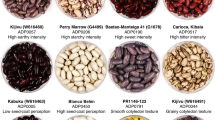Abstract
A profile of the sensory characteristics of greensoybean and consumer intent of purchasing the productwere determined. Thirty-one green soybean genotypesfrom maturity groups III to VI harvested between R6and R7 were frozen, boiled, shelled, and evaluated forcolor, texture, sweetness, nuttiness, beaniness,oiliness, aftertaste and overall eating quality bythree sensory panels. Results showed highly significant (p<0.01) variabilities among the genotypes in allsensory parameters and highly significant correlationsamong several parameters. The green soybeans, whenboiled, ranged from lightly green to green, wereslightly resistant to chewing, slightly nutty,slightly beany, not oily, imparted a pleasantaftertaste and had a fairly good overall eatingquality. The green soybeans would be potentiallyacceptable as a vegetable in the frozen state and foruse in recipes. When selecting genotypes forproduction, consideration should be given to thesensory attributes of the genotypes, because there wassignificant variability among the characteristics ofthe green soybeans, and several characteristicstogether enhanced the overall acceptability of thevegetable soybeans. To further increase theacceptability of green soybeans as a vegetable,geneticists need to consider breeding a vegetablesoybean that has as many desirable sensory attributesas possible.
Similar content being viewed by others
References
Fehr WR, Caviness CE, Burmood DT, Pennington JS (1971) Stage of development description of soybean (Glycine max (L) Merrill). Crop Sci 11: 929–930.
Gupta AK, Kapoor M, Deodhar AD (1976) Chemical composition and cooking characteristics of vegetable and grain-type soybeans. J Food Sci Tech 13: 133–137.
Konovsky J, Lumpkin TA, McClary D (1994) Edamame: The vegetable soybean. In: AD O'Rourke (ed), Understanding the Japanese Food and Agrimarket: A Multifacted Opportunity. Binghamton: Hayworth, pp 173–181.
Messina M, Messina V, Setchell K (1994) The Simple Soybean and your Health. Garden City Park, NY: Avery Publishing Group.
Carroll KK, Kurowska EM (1995) Soy consumption and cholesterol reduction: Review of animal and human studies. J Nutr 125: 549S–597S.
Sirtori CR, Even R, Lovati MR (1993) Soybean protein diet and plasma cholesterol: From therapy to molecular mechanism. Ann NY Acad Sci 676: 188–201.
Clarke R, Hilakivi-Clarke L, Cho E, James MR, Leonessa F (1996) Estrogens, phytoestrogens, and breast cancer. Adv Exp Med Biol Dietary Phytochem Cancer Prev Treat 401: 63–65.
Liu XH, Upadhyaya P, El-Bayoumy K, Rose DP (1996) The effect of dietary soy on human breast cancer metastasis in nude mice. Adv Exp Med Biol Dietary Phytochem Cancer Prev Treat 401: 283–284.
Dwyer J (1996) Is there a need to change the American diet? Adv Exp Med Biol Dietary Phytochem Cancer Prev Treat 401: 189–198.
Koratkar R, Sung M-K, Torzsas TL, Rao AV (1996) Effect of soybean saponins on aberrant crypt formation in mice. Adv Exp Med Biol Dietary Phytochem Cancer Prev Treat 401: 303.
Avila MS, Cansado J, Harter KW, Velasco JA, Norario V (1996) Quercetin as a modulator of the cellular neoplastic phenotype: Effects on the expression of mutated H-ras and p53 in Rodent and human cells. Adv Exp Med Biol Dietary Phytochem Cancer Prev Treat 401: 101–110.
Barnes S, Sfakianos J, Coward L, Kirk M (1996) Soy isoflavonoids and cancer prevention, underlying biochemical and pharmacological issues. In: Dietary Phytochemicals in Cancer Prevention and Treatment. New York, NY: Plenum Press, pp 87–99.
U.S.D.A., U.S.D.H.H.S. (1995) 1995 Dietary Guidelines for Americans. Home & Garden Bulletin No. 232.
United Soybean Board (1997) 1997 National Report on Consumer Attitudes about Nutrition. United Soybean Board, Seattle, WA.
Glanz K, Basil M, Maibach E, Goldberg J, Snyder D (1998) Why Americans eat what they do: Taste, nutrition, cost, convenience, and weight control concerns as influences on food consumption. J Am Dietetic Assoc 98: 1118–1126.
Statistical Analysis System (SAS) Institute (1985) User's Guide: Statistics, 5th edn. Cary, NC: SAS Institute.
Steel RG, Torrie JH (1980) Principles and Procedures of Statistics. New York: McGraw Hill.
Mohamed AI, Mebrahtu T, Rangappa M (1991) Nutrient composition and antinutritional factors in selected vegetable-type soybean (Glycine max). J Plant Foods Hum Nutr 41: 19–100.
Mebrahtu T, Mohamed A, Elmi A (1997) Accumulation of phytate in vegetable-type soybean genotypes harvested at four developmental stages. J Plant Foods Hum Nutr 50: 179–187.
Bowers J (1996) Food Theory and Applications, 2nd edn. New York: Macmillan Publ Co.
Mohamed A, Rangappa M (1992) Nutrient composition and anti-nutritional factors in vegetable soybean (Glycine (L) Merr) genotypes. II. Oil, fatty acids, sterols, and lipoxygenase activity. Food Chem 44: 277–282.
Author information
Authors and Affiliations
Rights and permissions
About this article
Cite this article
Young, G., Mebrahtu, T. & Johnson, J. Acceptability of green soybeans as a vegetable entity. Plant Foods Hum Nutr 55, 323–333 (2000). https://doi.org/10.1023/A:1008164925103
Issue Date:
DOI: https://doi.org/10.1023/A:1008164925103




